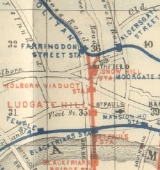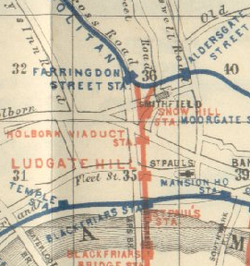
Snow Hill tunnel
Encyclopedia

City of London
The City of London is a small area within Greater London, England. It is the historic core of London around which the modern conurbation grew and has held city status since time immemorial. The City’s boundaries have remained almost unchanged since the Middle Ages, and it is now only a tiny part of...
between City Thameslink and Farringdon station
Farringdon station
Farringdon station is a London Underground and National Rail station in Clerkenwell, just north of the City of London in the London Borough of Islington...
s. The tunnel runs beneath the Smithfield meat market
Smithfield, London
Smithfield is an area of the City of London, in the ward of Farringdon Without. It is located in the north-west part of the City, and is mostly known for its centuries-old meat market, today the last surviving historical wholesale market in Central London...
and was constructed using the cut and cover method immediately prior to the building of the market. The tunnel opened on 1 January 1866.
Snow Hill tunnel was constructed by the London, Chatham and Dover Railway
London, Chatham and Dover Railway
The London, Chatham and Dover Railway was a railway company in south-eastern England from 1859 until the 1923 grouping which united it with other companies to form the Southern Railway. Its lines ran through London and northern and eastern Kent to form a significant part of the Greater London...
(LC&DR) to connect its tracks from the Ludgate Viaduct to those of the recently opened Metropolitan Railway
Metropolitan railway
Metropolitan Railway can refer to:* Metropolitan line, part of the London Underground* Metropolitan Railway, the first underground railway to be built in London...
's Widened Lines
Widened Lines
The Widened Lines is the name of a group of railway routes that currently form part of the Thameslink network leading from King's Cross/St...
south of Farringdon station. To the north-west, the Widened Lines in turn connected to the tracks of the Great Northern Railway
Great Northern Railway (Great Britain)
The Great Northern Railway was a British railway company established by the Great Northern Railway Act of 1846. On 1 January 1923 the company lost its identity as a constituent of the newly formed London and North Eastern Railway....
at King's Cross and the Midland Railway
Midland Railway
The Midland Railway was a railway company in the United Kingdom from 1844 to 1922, when it became part of the London, Midland and Scottish Railway....
at St Pancras
St Pancras railway station
St Pancras railway station, also known as London St Pancras and since 2007 as St Pancras International, is a central London railway terminus celebrated for its Victorian architecture. The Grade I listed building stands on Euston Road in St Pancras, London Borough of Camden, between the...
via tunnels running beneath the two main line termini
Terminal Station
Terminal Station is a 1953 film by Italian director Vittorio De Sica. It tells the story of the love affair between an Italian man and an American woman. The film was entered into the 1953 Cannes Film Festival.-Production:...
. Snow Hill tunnel thus provided the crucial link in the only north-south railway route through central London
London
London is the capital city of :England and the :United Kingdom, the largest metropolitan area in the United Kingdom, and the largest urban zone in the European Union by most measures. Located on the River Thames, London has been a major settlement for two millennia, its history going back to its...
, enabling cross London passenger and goods services to be run by a number of main line railway companies.
When first opened the tunnel had an additional eastwards connection to the Metropolitan Railway's tracks, enabling trains from the south to also serve Aldersgate Street
Barbican station
Barbican is a London Underground station serving the Barbican Estate and Centre in the City of London. It is on the Circle, Hammersmith & City and Metropolitan lines between and , in Travelcard Zone 1. Thameslink trains to and from Moorgate via Barbican ceased in March 2009.-History:The station...
(now Barbican) and Moorgate Street
Moorgate station
Moorgate station is a central London railway terminus and London Underground station on Moorgate in the City of London; it provides National Rail services by First Capital Connect for Hertford, Welwyn Garden City and Letchworth and also serves the Circle, Hammersmith & City, Metropolitan Lines and...
(now Moorgate) stations. The eastward curve also connected to a goods station
Goods station
A goods station is, in the widest sense, a railway station which is exclusively or predominantly where goods of any description are loaded or unloaded from ships or road vehicles and/or where goods wagons are transferred to local sidings.A station where goods are not specifically received or...
beneath Smithfield market. The curve and the goods station are no longer in use.
A station, also named Snow Hill, was opened in the tunnel in 1874 providing an interchange with the LC&DR's adjacent terminus at Holborn Viaduct station
Holborn Viaduct railway station
Holborn Viaduct was a railway terminus in central London.-History:During the 1860s and 1870s, had begun to struggle with increasing numbers of trains. At the time, the LCDR was suffering financial problems, and so was unable to raise capital to expand the station...
. Snow Hill station closed in 1916 although the tunnel remained in use for goods traffic until the end of the 1960s. Tracks were lifted in 1971 and the tunnel was abandoned for fifteen years until works began in 1986 to bring the north-south route back into operation as part of the Thameslink
Thameslink
Thameslink is a fifty-station main-line route in the British railway system running north to south through London from Bedford to Brighton, serving both London Gatwick Airport and London Luton Airport. It opened as a through service in 1988 and by 1998 was severely overcrowded, carrying more than...
route. New tracks were laid and services reopened in 1989.

A report in 2008 by The Planning Inspectorate into a proposed development of the General Market Building confirms that the tunnel structure, known as the lids, urgently require either repair or replacement. The tunnel lids are supported by girders which have deteriorated due to steam exhaust gases and, more recently, from wet conditions due to failed waterproofing of the decks above. Network Rail confirmed however that the condition of the structure is not dissimilar to many other structures of the same age on the network, and are comfortable that the structure is safe as it currently stands.
See also
- Ludgate Hill railway stationLudgate Hill railway stationLudgate Hill railway station was a station in the City of London opened by the London, Chatham and Dover Railway as its City terminus on 1 June 1865...
- closed station on the viaduct a short distance north of Blackfriars station. It was demolished with the viaduct.
External links
- Disused Stations - Snow Hill station - includes images of the tunnel

